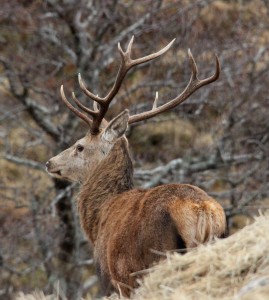 There is a great deal of publicity in the various media regarding red deer at present and mainly because estimates and direct counts indicate that there are far too many of them. Large numbers of red deer mean that there is just not enough food to go round and they are increasingly causing damage to the countrywide. It means that they are forced to go into areas where they are not normally found such as urban situations and more and more they frequent roadsides. There are also other problems such as the fact that more deer mean a greater number of road casualties. This causes not only great suffering for the deer but also damages vehicles and injures people. Another, often forgotten, problem is that the more deer you have to cull the less chance there is to be selective. Selecting the right deer cull to keep the deer in good condition is the normal standard of any stalker but taking large numbers of red deer out means that taking time for the correct selection is not always possible.
There is a great deal of publicity in the various media regarding red deer at present and mainly because estimates and direct counts indicate that there are far too many of them. Large numbers of red deer mean that there is just not enough food to go round and they are increasingly causing damage to the countrywide. It means that they are forced to go into areas where they are not normally found such as urban situations and more and more they frequent roadsides. There are also other problems such as the fact that more deer mean a greater number of road casualties. This causes not only great suffering for the deer but also damages vehicles and injures people. Another, often forgotten, problem is that the more deer you have to cull the less chance there is to be selective. Selecting the right deer cull to keep the deer in good condition is the normal standard of any stalker but taking large numbers of red deer out means that taking time for the correct selection is not always possible.
One answer would be to persuade more people to eat venison but this is not easy and there is also far too much venison still being transported all the way from New Zealand. Despite all the claims, you only have to look at some of the various stores in Inverness to see where the venison came from. If more people were persuaded to eat venison then the cost of culling would make it more feasible for estates to take more deer. However, despite all the publicity from numerous organisations about the quality of venison there are still very many people who are cautious about using it, let alone the price. One problem is over the way venison is prepared. If venison is prepared the right way from when the deer is shot there is no finer meat and the old adage “A meat fit for a King” is more than justified.
Last week I sat in a glen to the west of Inverness to spend some time photographing red deer stags and I thought about the problems the deer face. The stags are often at their lowest condition at this time of the year. The rut last Autumn will have taken its toll as some observers reckon that with all the challenging with other stags to compete for the harems of hinds they do not eat at all. So then they faced the winter and, although it has not been severe in the last few months, lack of food will have caused problems for the stags, especially with the high numbers. Once the spring is here then the stags can start getting more food and put on some weight. Then there is always the mating season or rut to look forward to in the Autumn.
However, there is still another major stage in the stags’ life cycle as they shed their antlers and re-grow them in time for the rut. This shedding or casting of antlers is somewhat of a mystery as it is obviously a great drain on the stags. Yet if their so called “fights” in the rut comes down to no more than display and bluff why have antlers? One suggestion has been that they were a natural defence against the time when wolves roamed the countryside. Antlers are aligned on the stag’s head so that the points are upright when a wolf is attacking the vulnerable neck. Next week we will look at the red deer hind annual cycle and see what problems they face.
